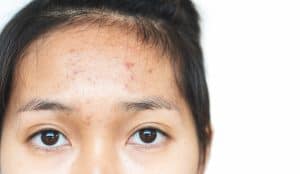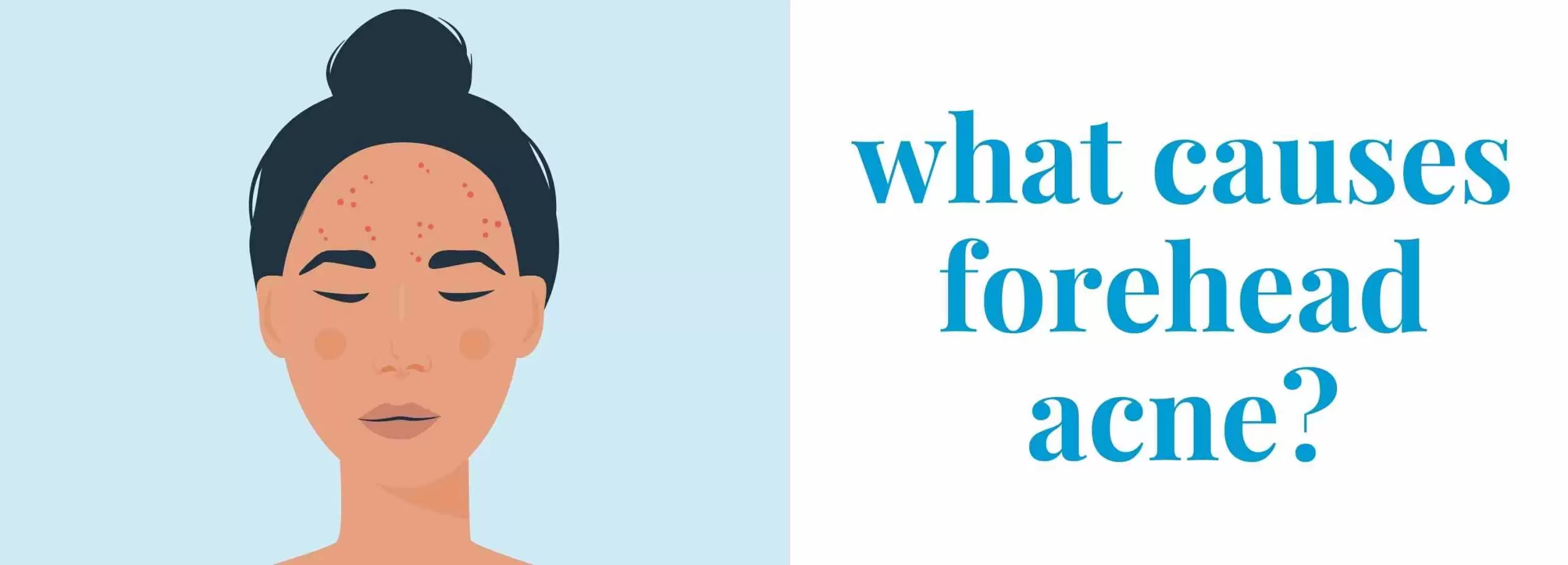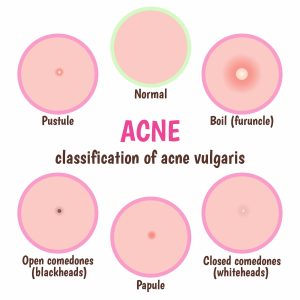Acne is a very common skin condition that causes pimples on the face, forehead, chest, shoulders, and upper back. However, many people only have acne in some places and their pimples only appear in specific spots on their face (like the forehead!).
Treating forehead acne is easier when you know why acne pop up. While it can be annoying, the good news is it’s fairly simple to learn what triggers acne and how to treat it!
In this article, you’ll discover what causes forehead acne, how to prevent it, and what acne treatment is best for you. With that knowledge, you can take the first steps towards acne treatment to finally saying, “Bye-bye, Acne & Hello Clear Skin!”

What Causes Forehead Acne?
Acne can come in many forms, at many stages in your life, and be caused by many different things; including genetics, fluctuating hormone levels (hello, Aunt Flo or menopause!), high humidity, and excess oil from makeup or lotion. But many people find that when acne appears on certain areas of their face regularly, the issues might be easier to pin-point.
Forehead acne is often caused by something blocking your skin’s pores. The sebaceous glands in your skin secrete oils to help keep the skin hydrated and healthy. But sometimes those glands get clogged. Your pores can also become clogged when dead skin cells accumulate and don’t shed naturally. These clogged pores can become irritated, causing acne.
Sometimes, acne on the forehead is caused by excess oil production. This is the excess of oils produced by your skin, because your forehead tends to be a naturally oily area. Forehead acne can also be caused by oily hair or makeup.
Types of Forehead Acne
Whiteheads and Blackheads
Also known as comedones, these types of acne are closest to the skin’s surface, and they’re the easiest to treat. Blackheads are open bumps on the skin that fill with excess oil and dead skin cells and commonly appear on your nose or chin. Whiteheads, on the other hand, are bumps that remain closed by oil and dead skin.
Papules and Pustules
These tend to be bigger, painful pimples caused by irritation to the pore, causing the walls of the pore to break down under the surface of the skin. Papules are raised bumps with no head and feel rough to the touch.
Pustules are like papules, but they are filled with pus (a white or yellow liquid). Pustules are large whiteheads surrounded by a red ring. These kinds of pimples might be more painful and harder to treat, requiring prescription treatments.
Milia
Also known as “milk spots,” these are small white bumps or cysts under the surface of the skin and are caused by trapped dead skin cells. Milia most often appear on the face and forehead are often confused with whiteheads. The main difference is that milia are not acne and will usually go away on their own. Milia usually happens in infants, but anyone can get them anywhere on their body.
Want to find the best birth control for acne?
Sign up for Pandia Health and our expert birth control doctors will find the best acne treatment for you.
- Starting at $7 per pack or FREE with insurance (cancel anytime)*
- FREE delivery and FREE goodies
- Expert care by expert birth control doctors
- With or without a prescription, we can help you!
*Pricing may vary based on medication
Best Treatment for Forehead Acne
If you’re experiencing acne troubles, know you’re not alone. Acne can be a stubborn and embarrassing skin condition, but everyone has had a pimple (or twenty!) at some point in their lives.
If you’re still stuck with annoying pimples and acne on your forehead after you’ve tried washing your face, switching your skin and hair care to non-comedogenic, or using natural remedies, it may be time to consider stronger treatment.
There are a number of prescription acne medications to choose from that your doctor can prescribe for you to treat acne. Doctors may prescribe the following types of medications, topical or oral, to help treat your acne:
- Retinoids: These are medications that contain retinoic acid or tretinoin and come as topical creams, gels, and lotions (think the brand name Differin from all those commercials 10 years ago). These drugs prevent hair follicles from becoming clogged, which can lead to irritation, infection, and the formation of pimples. They are first line for severe acne as well as for moderate acne.
- Antibiotics: These work by killing excess bacteria on your skin and reducing redness and inflammation caused by acne pimples. Antibiotics are a stronger option usually saved for cysts and inflammatory acne. They can be combined with benzoyl peroxide to reduce the likelihood of developing antibiotic resistance. These can come in topical creams, but you can also take them in pill form if your acne is really severe.
Some unrelated medications have the added benefit of treating acne, like combination birth control pills or Spironolactone, which is used to treat high blood pressure. Make sure to discuss these options with your doctor to see which option is right for you.
Looking for a Treatment for Forehead Acne?
Sign up for Pandia Health and our expert doctors will find the best treatment for you.
- Online acne treatment, bringing the doctor's office to you with telehealth services
- FREE delivery to your mailbox!
- Expert care by expert birth control doctors
- With or without a prescription, we can help you!
How to prevent forehead acne
Dealing with forehead acne can be frustrating, but don’t worry, there are effective ways to prevent it and achieve clearer, healthier skin! Here are some tips to help you out:
- Keep your forehead clean: Maintaining proper hygiene is crucial. Gently wash your face twice a day with a mild cleanser to remove excess oil, dirt, and impurities that can clog your pores. Avoid harsh scrubbing or abrasive products that can irritate your skin. Do NOT wash your face more than twice a day, otherwise your body will try to compensate for the overstripping of your natural oil and produce MORE oil.
- Avoid touching your face: Our hands come into contact with lots of bacteria and germs. Try not to touch your face, especially your forehead, to prevent transferring bacteria and oil that can cause acne. If you need to touch your forehead, make sure your hands are clean or use a tissue or clean cloth as a barrier.
- Choose non-comedogenic products: Many skincare and cosmetic products can clog your pores and lead to acne breakouts. Opt for non-comedogenic products that won’t block your pores. Look for labels with “non-comedogenic” or “oil-free” to ensure they’re best for acne-prone skin.
- No greasy hair products: Hair products can contain oils that can transfer onto your forehead and clog your pores. Keep your hair away from your face. If you have bangs or fringe, wash and style them off of your face regularly to prevent oil buildup.
- Stay hydrated: Drinking enough water is essential for healthy skin. It helps flush out toxins and keeps your skin hydrated, reducing the chances of acne breakouts. Aim for at least eight glasses of water per day to help achieve a clear complexion.
- Reduce stress levels: High-stress levels can trigger hormonal surges, leading to increased oil production and acne breakouts. Engage in stress-reducing activities like yoga, meditation, or regular exercise to keep stress in check.
- Get enough sleep! Make sure you get enough sleep as lack of sleep can contribute to stress and acne breakouts. Most people’s bodies like 8 hours a night.
Incorporating these tips into your skincare routine and making some lifestyle adjustments can help prevent and reduce forehead acne. Remember to be consistent and patient, as it may take time to see noticeable improvements. If your acne persists or worsens despite your efforts, it’s advisable to consult a doctor for further evaluation and personalized treatment options. If you don’t have a doctor, we got you! Pandia Health offers online acne treatment making hormonal care easy, affordable, and accessible!
Takeaways
Getting rid of forehead acne can be as simple and easy as remembering to wash your face twice a day. But acne can also be more stubborn than that. Just know that you’re not the only one with pimples and it’s not the only thing people see when they look at you. (They’re looking at your gorgeous eyes and dazzling smile, obviously!)
If you’re suffering from stubborn forehead acne, look for skincare products with active ingredients like salicylic acid, benzoyl peroxide, tea tree oil, and zinc. If you’re still not having the results you want, reach out to the expert doctors at Pandia Health for stronger treatment options so you can say goodbye to those awful pimples!
Disclaimer: The above information is for general informational purposes only and is NOT a substitute for professional medical advice. Always seek the advice of your doctor or healthcare provider before starting or changing acne treatment.


